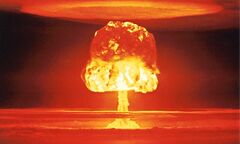Difference between revisions of "Mutually Assured Destruction"
(Importing from WP and expanding) |
(History) |
||
| Line 5: | Line 5: | ||
}} | }} | ||
'''Mutually Assured Destruction''' ('''MAD''') is a doctrine of military strategy and national security policy in which a full-scale use of [[nuclear weapons]] by two or more opposing sides would cause the complete annihilation of both the attacker and the defender (see pre-emptive nuclear strike and second strike). It is based on the theory of deterrence, which holds that the threat of using strong weapons against the enemy prevents the enemy's use of those same weapons. The strategy is a form of [https://en.wikipedia.org/wiki/Nash_equilibrium Nash equilibrium] in which, once armed, neither side has any incentive to initiate a conflict or to disarm.<ref>''[https://www.jstor.org/stable/3183553 "Mutual Assured Destruction"]''</ref> | '''Mutually Assured Destruction''' ('''MAD''') is a doctrine of military strategy and national security policy in which a full-scale use of [[nuclear weapons]] by two or more opposing sides would cause the complete annihilation of both the attacker and the defender (see pre-emptive nuclear strike and second strike). It is based on the theory of deterrence, which holds that the threat of using strong weapons against the enemy prevents the enemy's use of those same weapons. The strategy is a form of [https://en.wikipedia.org/wiki/Nash_equilibrium Nash equilibrium] in which, once armed, neither side has any incentive to initiate a conflict or to disarm.<ref>''[https://www.jstor.org/stable/3183553 "Mutual Assured Destruction"]''</ref> | ||
| + | |||
| + | ==History== | ||
| + | A research writing for the [[RAND corporation]] mentions that that this [[think tank]]: "was central to the development of modern deterrence theory".<ref>https://www.rand.org/content/dam/rand/pubs/monographs/2008/RAND_MG636.pdf</ref> | ||
==Irrational== | ==Irrational== | ||
Revision as of 01:37, 18 October 2022
 | |
| Interest of | RAND |
Mutually Assured Destruction (MAD) is a doctrine of military strategy and national security policy in which a full-scale use of nuclear weapons by two or more opposing sides would cause the complete annihilation of both the attacker and the defender (see pre-emptive nuclear strike and second strike). It is based on the theory of deterrence, which holds that the threat of using strong weapons against the enemy prevents the enemy's use of those same weapons. The strategy is a form of Nash equilibrium in which, once armed, neither side has any incentive to initiate a conflict or to disarm.[1]
History
A research writing for the RAND corporation mentions that that this think tank: "was central to the development of modern deterrence theory".[2]
Irrational
The term Mutually Assured Destruction, commonly abbreviated MAD, was coined by Donald Brennan, a strategist working in Herman Kahn's Hudson Institute in 1962. However, Brennan came up with this acronym ironically, spelling out the English word "mad" to argue that holding weapons capable of destroying society was irrational.
In 1962, the concept of mutually assured destruction started to play a major part in the defence policy of the US. President Kennedy's Secretary of Defense, Robert McNamara, set out in a speech to the American Bar Foundation a theory of flexible nuclear response.
In essence it meant stockpiling a huge nuclear arsenal. In the event of a Soviet attack the US would have enough nuclear firepower to survive a first wave of nuclear strikes and strike back. The response would be so massive that the enemy would suffer "assured destruction".
Thus the true philosophy of nuclear deterrence was established. If the other side knew that initiating a nuclear strike would also inevitably lead to their own destruction, they would be irrational to press the button.[3]
References
Wikipedia is not affiliated with Wikispooks. Original page source here